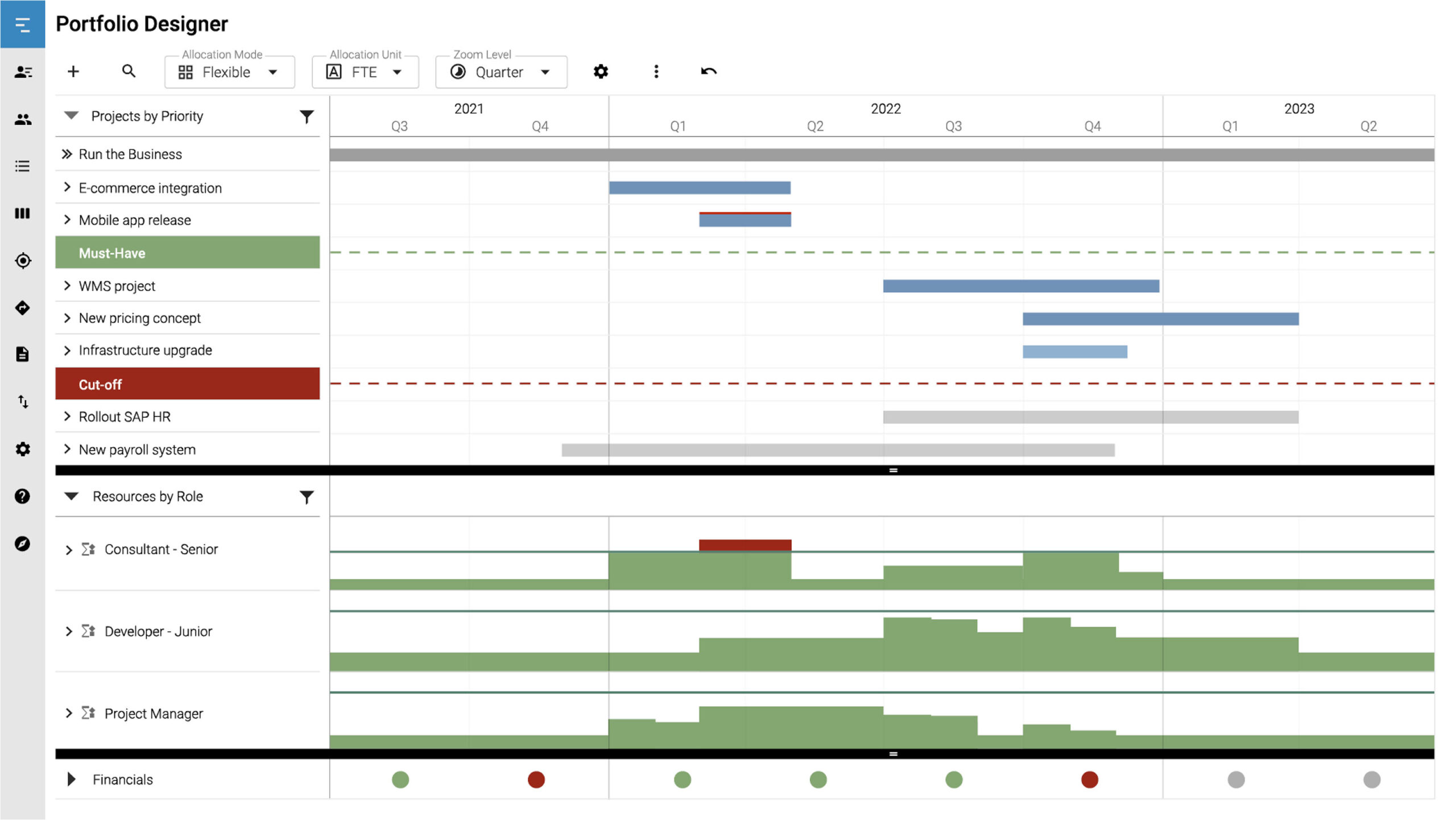When it comes to successful and on-time projects, what is the most important factor? For us at Meisterplan, the answer is always the people. We believe that expert employees are any organization’s most valuable asset. Your priorities are where you allocate your (human) resources. In other words, the most important projects require the most attention from expert employees. Therefore, good resource utilization and management are crucial for properly executing your strategy.
Are people resources?
People, employees, resources… They’re all one and the same. They’re the experts you need to successfully complete your projects.
While the word “resources” can sometimes refer to materials or finances, we’re only talking about human resources in this blog post. If you’re wondering why, then you might be interested in our previous blog post on the topic.
Resource management is straightforward on the surface level – where do you allocate your people? But there’s much more to consider when you dig deeper.
You want to ensure your team meets all their project deadlines, while also making sure they have the time they need to focus on their work. To accomplish this, you need to make sure you are optimally utilizing the resources on your team.
But what exactly is optimal resource utilization?
Come with us in this blog post as we explore all the things you need to keep in mind to make sure your team’s workload stays perfectly balanced.
Table of Contents
Set Employees Up for Success
Teams thrive under good leadership, but being a good supervisor is much easier said than done. While expectations vary from situation to situation, our number one tip is always the same: know your people. Know what works best for them.
Some people are easily bored and thrive in fast-paced environments. Others might be easily overwhelmed when things start to pile up. It’s important for managers to manage the stress level of their teams. People need to feel like they are working on something meaningful but without feeling overburdened.
Maintain a Buffer
Our best practice is to only schedule resources for 80-95% of their total available capacity – although the exact number depends on your particular context. You need to consider both the amount of work your employees feel comfortable taking on at one time, and how much work absolutely needs to be done.
If additional capacity is needed unexpectedly, this 5-20% buffer gives your team the flexibility to shift things around. For example, you might need to invest extra time into a project that is taking longer than planned.
If the buffer isn’t completely used up, people can pull “nice-to-have” tasks out from a backlog of low-priority projects. With these tasks, there’s no pressure to complete everything by a certain time, but there is always something to work on. Plus, it might help your team get around to projects that you otherwise wouldn’t have the time to focus on.
Avoid Under-Allocating
We don’t recommend scheduling resources for anything less than 80% capacity. That’s a bit too much of a buffer, which might leave people twiddling their thumbs without a lot to do. Apart from feeling bored, employees might also start to feel underappreciated if their skills are never put to good use.
There’s also the economic factor to consider. It’s simply a waste of money for your organization if you aren’t using your resources when they’re available.
Unexpected Overtime?
On the complete other hand, it’s unavoidable to go over capacity every once in a while. If an employee has to work at 105% of their capacity for one month, it isn’t the end of the world! It only becomes problematic when it happens multiple months in a row. Then, it’s a clear sign that something is wrong and more problems may arise as a result.
The Psychological Effects of Burnout
It’s normal if employees have to put in a bit of overtime every now and then. Even with careful planning and forecasting, conditions can be dynamic, and things don’t always go as planned. But being consistently over capacity at work can lead to stress and, eventually, burnout.
Having non-stop, looming deadlines might force people to get tunnel vision, focusing solely on the work they need to complete. This creates a tense office atmosphere.
Everyone focusing on their own urgent tasks and having little patience with each other can take a dire toll on collaboration. Individual team members might start lacking outside perspectives on the work they’re doing, which affects overall quality and satisfaction.
Worst of all, suffering from burnout could lead to illness. Not only does all the stress take a toll on employees’ mental health, but it may even weaken their immune systems. In the short term, this means that people would need to take additional sick days to recuperate. In the long run, it could even result in employees leaving the organization all together.

Hidden Consequences for the Organization
Losing good people is always a heavy cost to an organization. Someone needs to take over the work they’ve been doing (putting more strain on the remaining team), or that work gets severely delayed. In the meantime, the company needs to spend both time and money to find and train a replacement as quickly as possible.
Delays and Bottlenecks
There are still more impacts to consider even if your experts aren’t leaving (yet). For one, project delivery takes much longer and wait times increase as there’s always another thing to take care of. It’s hard to see every project through to a timely completion when everyone’s in firefighting mode!
Even if it’s just one single person that’s tied up and unable to complete their part of the project, the entire process can come to a halt. The Theory of Constraints (part of Critical Chain Project Management) states that every production chain has a bottleneck, and that bottleneck determines how much the entire production chain can produce. This is because of project dependencies, meaning some project stages cannot start until the previous phases are completed.
The Dangers of Multitasking
Contrary to popular belief, multitasking can be pretty inefficient – it takes a lot of brain power to keep switching between unrelated tasks. It might feel like doing a lot means accomplishing a lot, but that’s not necessarily the case.
Error rates also go up when people are working on too many things. Mistakes can often slip through undetected when people don’t have the chance to dedicate their full attention to a particular project.
Lack of Innovation
Being spread too thin means not having the opportunity to reflect and innovate. How can resources expect to stretch their creative muscles when they don’t have space to breathe? No time to dwell on anything for too long – just toss it into the “done” pile and move onto the next task.
But there’s a huge difference between “good” and “good enough”. People just need the time and the opportunity to really make their work shine.
How to Solve Resourcing Conflicts
Okay, so it’s clearly bad practice to overwork your employees – that much is obvious. But it takes competent management skills to remedy a bad situation.
It isn’t as simple as reducing your team’s workload. What happens to all that work? Surely someone still has to do it at some point. But when? And by whom?
We recommend going from smallest to largest as you try to find a solution.
Team Level
The most straightforward solution is to find a replacement. Is there someone else on the team who is available to take over some work? In an ideal world, where everyone on the team is scheduled with a 5-20% capacity buffer, someone should hopefully have some time to spare.
Redistributing tasks when necessary helps to keep the team’s workload balanced. Plus, it’s a sign of excellent teamwork when you can tag a colleague in to help out.
Portfolio Level
If no one is available to sub in, then things get a little more complicated. Looking at your project portfolio, are there any projects that are less important or not as urgent? Maybe they can be rescheduled or put on hold, and some deadlines can be pushed back to lighten the load.
However, changes at this level will affect more than just your team. You would have to communicate with other managers and make sure everyone is okay with your proposed changes to the plan.
Organizational Level
When all else fails, you have to escalate the issue to the people above you. Make your case to upper management for reprioritization, even if some project managers don’t agree. Point out the potential consequences if things don’t change.
Or, ask for additional resources. If reprioritization just isn’t possible and the problem-project is imminent, your organization might need to outsource external staff for a short-term fix.
If this is an ongoing issue, then perhaps it’s time to consider hiring new employees that can be utilized in the future.
Forecasting and Scenario Modeling
In the best-case situation, you’ll be able to see overallocations well in advance and not as they’re happening. This way, you’ll have time to react and find solutions. For instance, if you see that project managers will be overbooked in the next year, you can think about whether it’s time to start recruiting. By starting the hiring process early, you have ample time to find the perfect people and to make sure that they are adequately onboarded.
Meisterplan is the ideal software for testing potential solutions and seeing how they play out. Our “what-if” scenario comparison feature lets you simulate alternatives until you find something that works. Forget relying on gut feelings and hunches; Meisterplan helps you implement data-backed solutions that actually help solve the problem.

Read Next

Resource Management Doesn’t Have to Be Rocket Science. Try Our Simple Approach.



